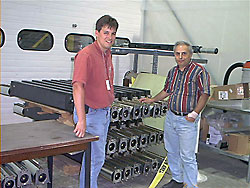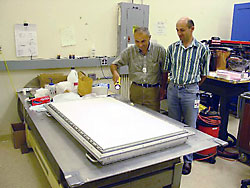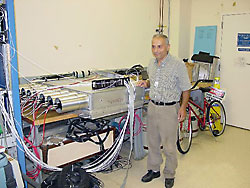Razmik (right) and JLab user Glen Warren (University of Basel, Switzerland) prepare to move the Hall C neutron detectors for the Gen experiment after completing assembly and testing.
In Memoriam
Razmik Asaturyan, 1954 - 2006
CEBAF-Yerevan Collaboration
Hall C Visiting Scientist
He was only 52 years old. On the evening of 15 June 2006, about 22:30 (10:30 p.m.). I found Razmik on the apartment floor. I called 911 for help. But no one could bring Razmik back. The doctor told us that Razmik passed away instantly due to a massive heart attack.
Razmik had always been a hard worker and even on the last day of his life, he worked hard without any indication that he would suddenly and tragically be dead.
He was born in Karabakh into a hard working family. His father, Arshak, and mother, Varsenik, despite many difficulties and hardships, provided their son with a good education.
In the early 70's, after completing high school, Razmik moved to Yerevan to continue his education at Yerevan State University. There, during his last year of studies, he found his sweetest friend and future wife, Clara.
Starting in 1975, upon his graduation from university, he worked in the Laboratory of Detectors at Yerevan Physics Institute (YerPhI). For a short period early in his career, Razmik worked on the construction and maintenance of spark chambers. Soon after, Razmik shifted his interests to the construction of wire chambers. The group he was in successfully constructed and installed a series of MWPC (Multiwire Proportional Chambers) for many experiments at the Yerevan Electron Accelerator. This system of MWPCs made it possible to carry out a series of important experiments on photon and electron beams at YerPhI (such as deuterium photo-disintegration, short-range correlations and channeling).
Razmik was also involved in experiments which were carried out by the YerPhI-JINR collaboration (the Joint Institute for Nuclear Research) in Dubna, Russia. His interest in experimental techniques and in the development of high-energy detectors was unceasing. He constantly worked to come up with new ideas. Razmik received his Ph.D. in 1990 and has been a head of the "Laboratory of Detectors" at YerPhI since 1995.
Razmik views the Aerogel detector before its installation into the Hall C High Momentum Spectrometer.
In addition to Razmik's professional legacy, he will long be remembered for the assistance he freely gave to young people with their education and progress in science. He helped young Armenian students with their English, and shared with them his knowledge and understanding of modern experimental techniques. Without any financial support, he translated the book "Detectors in Modern Experimental Physics" into Armenian so more students would have access to the knowledge. He even paid for publication of the translated book from his own pocket. Razmik helped the Yerevan State University Physics Department with the development and construction of a stand for cosmic ray studies with MWPCs.
As a member of Jefferson Lab's Yerevan collaboration, Razmik played an active role in the preparation, commissioning, data taking and analysis of many Hall C experiments. He was involved in and worked on the HNSS experiment Lucite detector, the Gen experiment's neutron detectors and the gain monitoring system, and a study of the HMS (High Momentum Spectrometer) and SOS (Short Orbit Spectrometer) hodoscopes degradation problem.
Razmik had a significant role in the construction, assembly and commissioning of the HMS Aerogel detector. We -- his colleagues and friends -- are very sorry that Razmik's dream and ideas for calibrating and using the Lead-Tungsten "mini-calorimeter" for Compton Polarimetry will be done without him. With Razmik's insight and experience, we were able to resolve technical problems and in a short time produce more than 1500 optical paddles for the GEp-III BigCal calorimeter.
He was full of energy and had far-reaching plans for the future. He was involved in preparation of the 12 GeV CDR (Conceptual Design Report). His dream was to construct new calorimeter gas Cerenkov and Aerogel detectors for SHMS (Super HMS). He had an idea for improving the PID (particle identification) capability of HMS and SHMS via data flow from the drift chambers.
He was a person with high morals and was friendly with everyone. He was a hard and ready worker and a good physicist. We will remember him as he was.
Razmik leaves behind a good family: his wife, son and daughter. His lovely wife Clara is a teacher, daughter Zara is a graduate student, and son Arshak is pursuing his magisterial (master's degree) and works at YerPhI.
Hamlet Mkrtchyan
CEBAF-Yerevan Collaboration
Hall C Visiting Scientist
More information:




